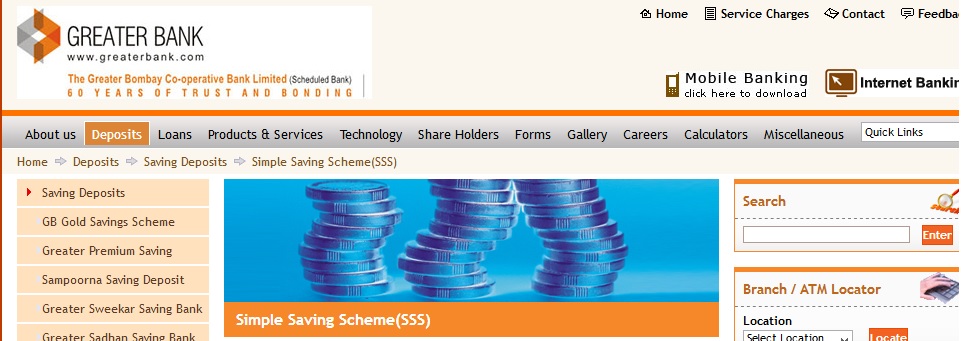greaterbank.com : SSS Simple Saving Scheme
Organisation : Greater Bank, The Greater Bombay Co-operative Bank Ltd
Facility : Simple Saving Scheme SSS
Web Site : https://www.greaterbank.com/
| Want to ask a question / comment on this post? Go to bottom of this page. |
|---|
SSS Simple Saving Scheme
Account can be opened with a minimum balance of Rs. 10/- only. The scheme is applicable strictly to individuals, i.e the A/c can be opened by individuals, literate / illiterate, physically handicapped. Senior citizens, including minors in the age group of 10-18 years.
Related : Greater Bank Sweekar Saving Bank Scheme : www.statusin.in/22873.html
Account can be opened, with a minimum initial deposits of Rs.10/- and the account will remain active, even if the balance goes below Rs.10/-.
No personalised chequebook, ATM cum Debit card facility collection of utility bills (Bill centre facility) shall be allowed. Withdrawals will be allowed only against production of passbook and withdrawal slip to the account holder only.

** Depositing of local cheques / P.O./ DD for credit will be allowed
** Maximum credit in the account not to exceed Rs.50,000/- and total turnover in a year not to exceed Rs.1,00,000/- (Rupees one lac only).
In the event, the above limitations are crossed, branch should close the a/c and transfer the a/c to normal SB portfolio, after complying with the KYC norms
** Rate of interest shall be applicable to SB a/c (i.e. @ 4.00% p.a.)
** Only three withdrawal transactions shall be allowed in a month
** No transaction charges of the amounts transferred within the branch. All other remittances to outside agencies shall be allowed at normal applicable service charges
** No service charges shall be levied, including for balances below the minimum balances and zero balance
FAQs :
What is RTGS System?
The acronym “RTGS” stands for Real Time Gross Settlement. RTGS system is a funds transfer mechanism where transfer of money takes place from one bank to another on a “real time” and on “gross” basis.
This is the fastest possible money transfer system through the banking channel. Settlement in “real time” means payment transaction is not subjected to any waiting period. The transactions are settled as soon as they are processed.
“Gross settlement” means the transaction is settled on one to one basis without bunching with any other transaction. Considering that money transfer takes place in the books of the Reserve Bank of India, the payment is taken as final and irrevocable.
How RTGS is different from Electronic Fund Transfer System (EFT) or National Electronics Funds Transfer System (NEFT)?
EFT and NEFT are electronic fund transfer modes that operate on a deferred net settlement (DNS) basis which settles transactions in batches. In DNS, the settlement takes place at a particular point of time. All transactions are held up till that time.
For example, NEFT settlement takes place 6 times a day during the week days ( 9.00 am, 11.00 am, 12.00 noon, 1.00 pm, 3.00 pm and 5 pm) and 3 times during Saturdays ( 9.00 am, 11.00 am and 12.00 noon).
Any transaction initiated after a designated settlement time would have to wait till the next designated settlement time. Contrary to this, in RTGS, transactions are processed continuously throughout the RTGS business hours.
Would the remitting customer get back the money if it is not credited to the beneficiary’s account? When?
Yes. It is expected that the receiving bank will credit the account of the beneficiary instantly. If the money cannot be credited for any reason, the receiving bank would have to return the money to the remitting bank within 2 hours.
Once the money is received back by the remitting bank, the original debit entry in the customer’s account is reversed.
What is the essential information that the remitting customer would have to furnish to a bank for the remittance to be effected?
The remitting customer has to furnish the following information to a bank for effecting a RTGS remittance :
1. Amount to be remitted
2. Account number which is to be debited
3. Name of the beneficiary bank
4. Name of the beneficiary customer
5. Account number of the beneficiary customer
6. Sender to receiver information, if any
7. The IFSC code of the receiving branch
How would one know the IFSC code of the receiving branch?
The beneficiary customer can obtain the IFSC code from his branch. The IFSC code is also available in the cheques leaf. This code number and bank branch details can be communicated by the beneficiary to the remitting customer.
About Us :
The Greater Bombay Co-operative Bank Ltd, more popularly known as Greater Bank, had its humble beginnings over five decades ago on 10th December 1952, when a small group of philanthropists got together to set up the Bank.
Though the founders were pursuing interests of their own, they decided to establish the bank with the sole motto of serving the community at large.With this end in view, they introduced attractive deposit and lending schemes relevant to the times.
Contact Us :
The Greater Bombay Co-operative Bank Ltd,
Churchgate Chambers, Ground floor,
Sir Vithaldas Thackersey Marg,5,
New Marine Lines ,
Mumbai – 400020.